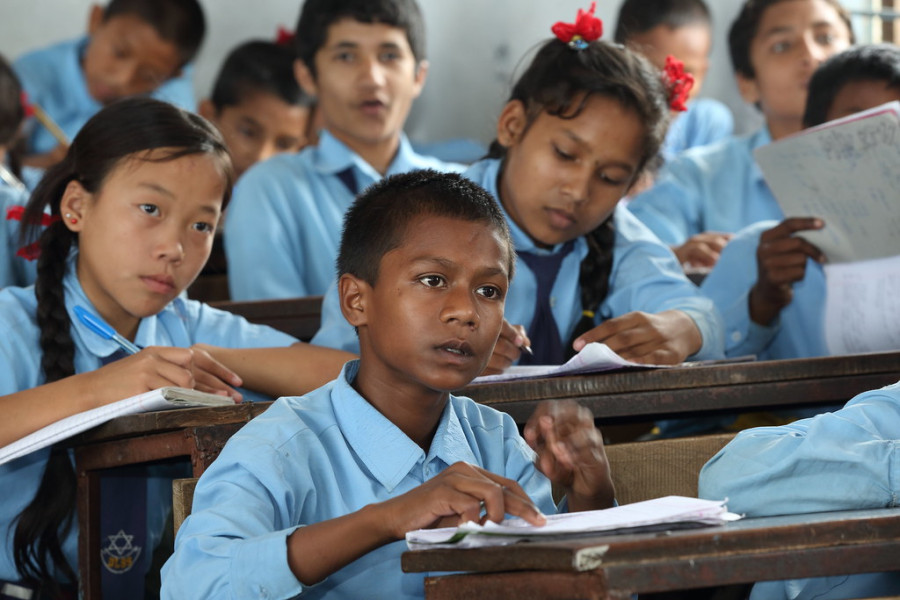Columns
Addressing the learning crisis
Public sector officials, workers and politicians should be required to send their children to community schools.
Shyam Dahal
Nobody would fail was the promise when the School Leaving Certificate (SLC) examination was changed into the Secondary Education Examination (SEE). But the euphoria of the promise soon faded as successive SEE results could not substantiate it. This year’s SEE results have also followed the same old pattern. Around 460,000 regular students participated in last year’s SEE, 71 percent of whom were from community schools. About 50,000 students scored a grade point average (GPA) of less than 1.6, the minimum required to get admission into higher secondary education. About 150,000 did not get a 2.0 GPA, the minimum required to apply for a government job.
The poor results have cast a shadow of uncertainty over the future of an overwhelmingly large number of students. What is even more disconcerting and likely to raise people’s hackles is the fact that the low scorers mainly came from community schools where the state’s investment is huge, teacher salaries and perks are higher, and teachers are supposed to be better qualified and trained than those in private schools.
Extreme pessimism
The continuous failure of the public education system has generated cynicism to such an extent that it is hard to find someone who believes that it can be improved in Nepal. This kind of extreme pessimism is detrimental to the future of public education. What is ailing our community schools? Why is the learning crisis so prevalent and persistent despite the expansion of public education in terms of the growing number of schools, student enrolment, teacher recruitment and education budget? The oft-cited reasons behind such dismal performances include corruption in the education budget, inadequate school resources, political interference, involvement of teachers in party politics and their absenteeism, irregularities in teacher appointments, inappropriate curricula, and the non-availability of textbooks.
According to the World Bank’s World Development Report 2018, the main reasons behind the debacle of public education in developing countries include pupils’ lack of readiness to learn, teachers without required skills and motivation, poor school management skills, and inadequate school inputs failing to match the education expansion drive. These are, of course, no small problems. But digging deeper, we can notice some serious structural issues that underlie these problems, and which are at the root of the present learning crisis in Nepal.
Sam Hickey and Naomi Hossain, in their work ‘The Politics of Education in Developing Countries: From Schooling to Learning’ published in 2019 by the Oxford University Press, pointed out that generating high quality learning is difficult in poor countries for various reasons, the most important of which is institutional or personal prejudices against students from poor, marginalised or vulnerable communities. Other difficulties include an unfavourable home environment, weak cognitive abilities due to chronic malnourishment, dropouts, poor attendance, child labour, and other typical characteristics of childhood observed in extreme poverty. Thus, poverty and inequality are at the heart of the problem. This insight is particularly relevant and useful for Nepal, where a disproportionately large number of pupils in community schools come from poor socioeconomic backgrounds. As these factors very closely resemble the actual situation in Nepal, it is not difficult to see why our education system is in such shambles.
So what can be done to improve the quality of school education in Nepal? One obvious answer would be to reduce poverty and inequality. But it will take a long time to do that. Other more short-term measures might include increasing
the education budget, making education free, recruiting more qualified teachers, opening more schools with better infrastructure, improving the student-teacher ratio, increasing enrolment, training teachers, designing appropriate curricula and providing free meals to students. But the irony in Nepal is that most of these changes are already in place, and there still is no perceived improvement in education quality.
The answer, most probably, lies in the almost non-existent public accountability in Nepal’s education system. One consequence of poverty and inequality is that students and their parents do not have the voice and power to hold the teachers, school management and policymakers accountable for the poor education quality. In the absence of accountability, nobody feels the pressure and obligation to perform better by utilising efficiently and effectively the resources already available. Thus, unless accountability relations in the public education system are strengthened and made operational, all other initiatives of reform will likely remain toothless and fail to generate the desired impact.
As emphasised by the World Development Report 2004, there are four critical components of public accountability relations between education service users and service providers that need revamping to improve educational outcomes: (1) Voice, or how well citizens can hold politicians and policymakers accountable for performance in discharging their responsibility for education; (2) Compacts, or how well and how clearly the responsibilities and objectives of public engagement are communicated to the public; (3) Management, or the actions that create effective frontline providers (teachers, administrators) within organisations; and (4) Client power, or how well citizens, as clients, can increase the accountability of schools and school systems.
Community schools
Once again, poverty and inequality stand in the way towards improving these accountability relations in Nepal. One cannot realistically expect poor students and their uneducated and indigent parents, who currently constitute a great majority of beneficiaries of public education, to exercise voice and client power or to understand compacts in the accountability framework. And since poverty and inequality reduction policies take time to show results, the government in the meantime may seek to mitigate this accountability gap with immediate effect by introducing a much-talked-about provision requiring all public sector officials and workers including politicians who draw salaries and perks from the state coffers to compulsorily send their children to community schools.
Needless to say, these are the group of citizens who possess the voice, power and all other resources necessary to make the entire public education system accountable for its performance. The presence of students from richer sections of society would also give community schools a much-needed egalitarian look. Moreover, the change can be effected at the stroke of a pen with a few additional resources required, if any.
Dahal is pursuing a master’s degree in public administration at the University of Melbourne, Australia.




 21.63°C Kathmandu
21.63°C Kathmandu















